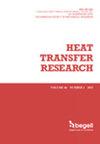EXPERIMENTAL STUDY ON IMPROVING HEAT TRANSFER ABILITY OF A HEAT PIPE UTILIZING IRON OXIDE-FERRIC OXIDE HYBRID AND NICKEL FERRITE MONO-MAGNETIC NANOFLUIDS
IF 1.6
4区 工程技术
Q3 THERMODYNAMICS
引用次数: 1
Abstract
Heat carrier refining of a heat pipe employing the iron oxide-ferric oxide hybrid magnetic nanofluid and nickel ferrite mono-magnetic nanofluid as an operating medium in the process of various performing conditions was investigated experimentally. A thermosyphon-type heat pipe constructed of copper with 20-mm internal and 18-mm external diameters was used in this experimental work. The fulfillment of the heat pipe was examined by operating three separate operating fluids: distilled water, hybrid and mono-magnetic nanofluids. The fluid was injected into the system with a filling ratio equal to 1/3 of the total volume of the heat pipe for all individual experiments. Practical analysis was performed under three distinct input heats and two different nanofluid weight percent as an operating medium in the evaporator section and three different coolant mass flow rates in the condenser area of the system. Wall temperature fluctuations, index factor (efficiency), Nusselt number, and thermal resistance magnitudes were obtained for distilled water, iron oxide-ferric oxide hybrid magnetic nanofluid, and nickel ferrite mono-magnetic nanofluid for each experiment. The highest improvement rates in heat transfer ability, Nusselt number, and heat pipe thermal resistance magnitude were 30.55%, 26.9%, and 61.8%, respectively, when the iron oxide-ferric oxide hybrid magnetic nanofluid was employed as an operating fluid compared to distilled water. The thermal performance of the system increased significantly with increasing the weight percent of both hybrid and mono-magnetic nanofluids. Basically, the efficiency of the system was improved by 3.92% by increasing the weight percent of the hybrid magnetic nanofluid from 0.5 wt.% to 1 wt.%.利用氧化铁-氧化铁杂化物和铁氧体镍单磁纳米流体提高热管传热能力的实验研究
实验研究了以氧化铁-氧化铁混合磁性纳米流体和镍铁氧体单磁性纳米流体为工作介质的热管的热载体精炼过程。本实验采用内径20mm,外径18mm的铜热虹吸式热管。通过运行蒸馏水、混合纳米流体和单磁纳米流体三种不同的操作流体来检查热管的性能。在所有单独的实验中,流体以热管总体积的1/3填充比例注入系统。在三种不同的输入热量和两种不同的纳米流体重量百分比作为蒸发器段的工作介质以及系统冷凝器区域的三种不同的冷却剂质量流量下进行了实际分析。得到了蒸馏水、氧化铁-氧化铁杂化磁性纳米流体和铁氧体镍单磁性纳米流体的壁温波动、指数因子(效率)、努塞尔数和热阻大小。与蒸馏水相比,以氧化铁-三氧化铁混合磁性纳米流体作为操作流体,其传热能力、努塞尔数和热管热阻大小的改善率分别为30.55%、26.9%和61.8%。随着混合纳米流体和单磁纳米流体重量百分比的增加,系统的热性能显著提高。基本上,将混合磁性纳米流体的重量百分比从0.5 wt.%增加到1 wt.%,系统的效率提高了3.92%。
本文章由计算机程序翻译,如有差异,请以英文原文为准。
求助全文
约1分钟内获得全文
求助全文
来源期刊

Heat Transfer Research
工程技术-热力学
CiteScore
3.10
自引率
23.50%
发文量
102
审稿时长
13.2 months
期刊介绍:
Heat Transfer Research (ISSN1064-2285) presents archived theoretical, applied, and experimental papers selected globally. Selected papers from technical conference proceedings and academic laboratory reports are also published. Papers are selected and reviewed by a group of expert associate editors, guided by a distinguished advisory board, and represent the best of current work in the field. Heat Transfer Research is published under an exclusive license to Begell House, Inc., in full compliance with the International Copyright Convention. Subjects covered in Heat Transfer Research encompass the entire field of heat transfer and relevant areas of fluid dynamics, including conduction, convection and radiation, phase change phenomena including boiling and solidification, heat exchanger design and testing, heat transfer in nuclear reactors, mass transfer, geothermal heat recovery, multi-scale heat transfer, heat and mass transfer in alternative energy systems, and thermophysical properties of materials.
 求助内容:
求助内容: 应助结果提醒方式:
应助结果提醒方式:


